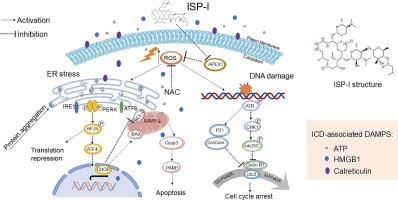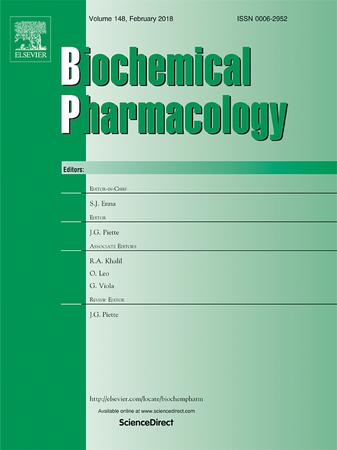异戊酰螺霉素 I 通过 ATR/CHK1 介导的 DNA 损伤反应和 PERK/eIF2α/ATF4/CHOP 介导的 ER 应激抑制小细胞肺癌的增殖。
IF 5.3
2区 医学
Q1 PHARMACOLOGY & PHARMACY
引用次数: 0
摘要
小细胞肺癌(SCLC)迫切需要新的治疗方法。我们发现,抗生素衍生化合物异戊酰螺霉素 I(ISP-I)在体外和体内对小肺癌细胞株 H1048 和 DMS53 均有很强的抗肿瘤活性。ISP-I 可诱导两种细胞株出现细胞凋亡、G2/M 期细胞周期停滞和线粒体呼吸链功能障碍。综合 RNA 测序显示,ISP-I 的抗SCLC 作用主要归因于 ATR/CHK1 介导的 DNA 损伤反应和 PERK/eIF2α/ATF4/CHOP 介导的 ER 应激。重要的是,活性氧(ROS)清除剂N-乙酰-L-半胱氨酸(NAC)减轻了ISP-I对DNA损伤、ER应激和细胞凋亡的诱导作用,强调了ROS在ISP-I抗SCLC机制中的关键作用。此外,ISP-I还能诱导SCLC细胞的免疫原性细胞死亡(ICD),三磷酸腺苷(ATP)分泌增加、高迁移率基团框1(HMGB1)释放增加以及细胞表面钙网蛋白(CRT)暴露增加都证明了这一点。此外,网络药理学分析结合细胞热转移试验(CETSA)和环己亚胺(CHX)追逐实验证明,ISP-I 是嘌呤/近嘧啶内切酶 1(APEX1)的配体,能促进其降解,从而导致 ROS 的积累。总之,我们的研究结果阐明了ISP-I抗癌作用的多方面机制,凸显了它作为一种治疗SCLC的候选药物的潜力。本文章由计算机程序翻译,如有差异,请以英文原文为准。

Isovalerylspiramycin I suppresses small cell lung cancer proliferation via ATR/CHK1 mediated DNA damage response and PERK/eIF2α/ATF4/CHOP mediated ER stress
Small cell lung cancer (SCLC) urgently needs new therapeutic approaches. We found that the antibiotic-derived compound Isovalerylspiramycin I (ISP-I) has potent anti-tumor activity against SCLC cell lines H1048 and DMS53 both in vitro and in vivo. ISP-I induced apoptosis, G2/M phase cell cycle arrest, and mitochondrial respiratory chain dysfunction in both cell lines. Comprehensive RNA sequencing revealed that the anti-SCLC effects of ISP-I were primarily attributed to ATR/CHK1-mediated DNA damage response and PERK/eIF2α/ATF4/CHOP-mediated ER stress. Importantly, the induction of DNA damage, ER stress, and apoptosis by ISP-I was mitigated by the reactive oxygen species (ROS) scavenger N-acetyl-L-cysteine (NAC), underscoring the critical role of ROS in the anti-SCLC mechanism of ISP-I. Moreover, ISP-I treatment induced immunogenic cell death (ICD) in SCLC cells, as evidenced by increased adenosine triphosphate (ATP) secretion, elevated release of high-mobility group box 1 (HMGB1), and enhanced exposure of calreticulin (CRT) on the cell surface. Additionally, network pharmacology analysis, combined with cellular thermal shift assay (CETSA) and cycloheximide (CHX) chase experiments, demonstrated that ISP-I acted as a ligand for apurinic/apyrimidinic endonuclease 1 (APEX1) and promoted its degradation, leading to the accumulation of ROS. In conclusion, our findings elucidate the multifaceted mechanisms underlying the anti-cancer effects of ISP-I, highlighting its potential as a promising therapeutic candidate for SCLC treatment.
求助全文
通过发布文献求助,成功后即可免费获取论文全文。
去求助
来源期刊

Biochemical pharmacology
医学-药学
CiteScore
10.30
自引率
1.70%
发文量
420
审稿时长
17 days
期刊介绍:
Biochemical Pharmacology publishes original research findings, Commentaries and review articles related to the elucidation of cellular and tissue function(s) at the biochemical and molecular levels, the modification of cellular phenotype(s) by genetic, transcriptional/translational or drug/compound-induced modifications, as well as the pharmacodynamics and pharmacokinetics of xenobiotics and drugs, the latter including both small molecules and biologics.
The journal''s target audience includes scientists engaged in the identification and study of the mechanisms of action of xenobiotics, biologics and drugs and in the drug discovery and development process.
All areas of cellular biology and cellular, tissue/organ and whole animal pharmacology fall within the scope of the journal. Drug classes covered include anti-infectives, anti-inflammatory agents, chemotherapeutics, cardiovascular, endocrinological, immunological, metabolic, neurological and psychiatric drugs, as well as research on drug metabolism and kinetics. While medicinal chemistry is a topic of complimentary interest, manuscripts in this area must contain sufficient biological data to characterize pharmacologically the compounds reported. Submissions describing work focused predominately on chemical synthesis and molecular modeling will not be considered for review.
While particular emphasis is placed on reporting the results of molecular and biochemical studies, research involving the use of tissue and animal models of human pathophysiology and toxicology is of interest to the extent that it helps define drug mechanisms of action, safety and efficacy.
 求助内容:
求助内容: 应助结果提醒方式:
应助结果提醒方式:


